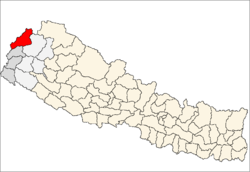Darchula District
| Darchula दार्चुला |
|
|---|---|
| District | |
 Location of Darchula |
|
| Country | Nepal |
| Region | Far-Western (Sudur Pashchimanchal) |
| Zone | Mahakali |
| Headquarters | Darchula |
| Area | |
| • Total | 2,322 km2 (897 sq mi) |
| Population (2011) | |
| • Total | 133,274 |
| Time zone | NPT (UTC+5:45) |
| Main language(s) | Dotiyali, Kumauni, Rung/Shauka, Nepali and others |
| Website | www |
Darchula District (Nepali: ![]() Listen , a part of Province No. 7, is one of the seventy-five districts of Nepal. The district, with Darchula as its district headquarters, covers an area of 2,322 km² and has a population (2011) of 133,274. The number of male 63,609 and female 69,855. Decadal Change(%) 9.40, Annual Growth Rate(%) 0.90, Sex Ratio(males per 100 females) 91, Absent (abroad) Population Total 6,867, where number of male 5,880 and female 987. Total Number of House 22,948. Total Number of Household 25,802. Average Household Size 5.17. Population Density 57 km2. The town has an indian counterpart to its northwest, named Dharchula. The split between the two towns is just virtual as the traditions, culture, and lifestyle of the people living across both the regions are quite similar.
Listen , a part of Province No. 7, is one of the seventy-five districts of Nepal. The district, with Darchula as its district headquarters, covers an area of 2,322 km² and has a population (2011) of 133,274. The number of male 63,609 and female 69,855. Decadal Change(%) 9.40, Annual Growth Rate(%) 0.90, Sex Ratio(males per 100 females) 91, Absent (abroad) Population Total 6,867, where number of male 5,880 and female 987. Total Number of House 22,948. Total Number of Household 25,802. Average Household Size 5.17. Population Density 57 km2. The town has an indian counterpart to its northwest, named Dharchula. The split between the two towns is just virtual as the traditions, culture, and lifestyle of the people living across both the regions are quite similar.
More than 56,000 people live in 8,989 households. About 58.4 percent of the population falls below the poverty line. Population composition is made up of different castes, such as Kshatriya 63.55%, Brahmin 17.15%, Thakuri 4.01%, Dalit and others contribute 15.39 percent. Hindu followers are high in numbers. Hindu, Buddhists, as well as others, regard nature as a gift from God and they worship nature their own way.
The majority ethnic group is Pahari Arya. Castes of Darchula District are Brahmin, Chhetries, Dalit, Thakuri, Lohar, Kaine, Newar, Byansi, Bandhe, Sanyasi etc. Among them 85.19% HHs are Brahmin/Chheties/Thakuri, 10% Dalits, 0.12% Sauka and others are occupational caste groups. Sauka are indigenous inhabitant’s caste group. The indigenous caste groups are dominated by migrants from other villages. The Dalits (7.35%) and Thakuri (7.43%) share equal proportions and occupy the second largest group in the total population. Indigenous groups Byansi represent 1.32%, Lohar 1.38% and other minorities’ correspondent to 1.48 percent. Dalits are also defined as the Special Target Groups (STGs).
...
Wikipedia
